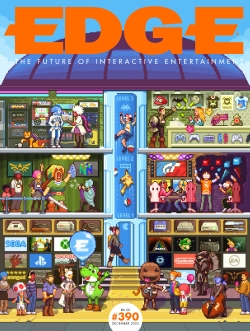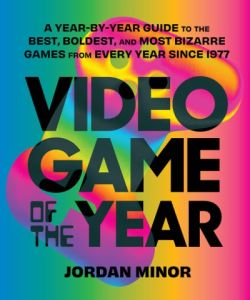
Eurogamer has been doing a lot of interesting stuff this year to celebrate their 25th birthday (I hope you got the chance to try out the Theme Switcher to see what the site looked like through the years). And about six weeks ago they even attempted to capture “the best games to play in this specific moment” with “The Eurogamer 100”:
Welcome to the Eurogamer 100, a list of video games that aims to reflect their ever-changing nature. Rather than ranking games by their influence or significance, the below list is a suggestion of the very best things you can play at this moment, according to us. We’ve aimed to cover the full breadth of what modern video games can be – and in doing so were reminded, suddenly, that 100 games really isn’t very many at all – while everything on the list must be legitimately obtainable at the time of writing on current-generation hardware. And crucially, it has to currently be brilliant.
Our hope is that this list will be as useful as it is conversation-starting, be that through suggesting exceptional games that may not be on everyone’s radar already, reminding you of long-running classics that have remained timeless, or highlighting those that have found themselves with renewed energy and form.
The key element of “The Eurogamer 100” is that the games included have to be “legitimately obtainable” on “current-generation hardware” to be eligible, which helps make the list a fantastic overview of the last decade (more-or-less) of video games. You’ll find Game of the Year heavyweights (Breath of the Wild at #5, Baldur’s Gate 3 at #6, and Elden Ring at #8) sitting alongside indie darlings (Tunic at #12, Hades at #34, and Animal Well at #36), but I think the Top 3 (Tetris Effect at #1, Mario Kart 8 Deluxe at #2, and Outer Wilds at #3) really does capture what video games are about right now.
And thanks to an avalanche of re-releases and the rise of forever games, you’ll also find a few titles that debuted outside that ten-year window, including 2011’s Minecraft (#28) 1991’s Super Mario World (#72), and 2009’s League of Legends #73.
But with such a wide timeframe and such an abundance of choices (100 really isn’t a lot), the number of omissions is staggering. That includes big favorites from recent years (neither Red Dead Redemption is present), as well as one of my personal favorites that’s still available even though it’s nearing it’s 20th anniversary (that would be Geometry Wars: Retro Evolved 2).
But maybe that’s for a future update of “The Eurogamer 100”. Deputy Editor Chris Tapsell said that we should expect the list to be a dynamic list, and that updates will be made yearly:
Unlike most lists out there, the Eurogamer 100 isn’t a list of the greatest games of all time, but of the best games to play in this specific moment.
We’ll then come back to the list and update it once per year, adding particularly brilliant new games that might have launched, old games that have found new life, and replacing those that may have found themselves in something of a dip.
The rest of “The Eurogamer 100” can be found after the break.



 Justin McElroy, Griffin McElroy, Chris Plante, and Russ Frushtick host The Besties, a podcast where they talk about “the best game of the week” every week.
Justin McElroy, Griffin McElroy, Chris Plante, and Russ Frushtick host The Besties, a podcast where they talk about “the best game of the week” every week.
 The magazine racks at your local bookstore (or even your local Barnes & Noble) are mostly empty these days. And that’s doubly-true for game-focused publications like Nintendo Power, GamePro, and Electronic Gaming Monthly, all of which closed down more than a decade ago.
The magazine racks at your local bookstore (or even your local Barnes & Noble) are mostly empty these days. And that’s doubly-true for game-focused publications like Nintendo Power, GamePro, and Electronic Gaming Monthly, all of which closed down more than a decade ago.



 The Times delivered its first daily edition to the people of London all the way back in 1785. The newspaper has reported on some of the biggest stories the world has ever seen in the nearly 240 years since, and they’ve given space to pieces from a very distinguished array of writers over the centuries, including Charles Dickens, Sir Arthur Conan Doyle, Oscar Wilde, and Albert Einstein.
The Times delivered its first daily edition to the people of London all the way back in 1785. The newspaper has reported on some of the biggest stories the world has ever seen in the nearly 240 years since, and they’ve given space to pieces from a very distinguished array of writers over the centuries, including Charles Dickens, Sir Arthur Conan Doyle, Oscar Wilde, and Albert Einstein.
 PC Magazine’s Jordan Minor will publish his first book in 2023, and for the subject of this tome, the journalist has zeroed in one that’s very near and dear to my heart.
PC Magazine’s Jordan Minor will publish his first book in 2023, and for the subject of this tome, the journalist has zeroed in one that’s very near and dear to my heart.



 The Xbox Series X|S and the PS5 are steamrolling their way towards store shelves this November, and earlier this month, GameSpot became one of the first outlets to produce a retrospective of the generation we’re about to leave behind. Or are we? With cross-platform compatibility more important than ever, and the Switch still going strong, the upcoming generation will probably look a lot like our current one.
The Xbox Series X|S and the PS5 are steamrolling their way towards store shelves this November, and earlier this month, GameSpot became one of the first outlets to produce a retrospective of the generation we’re about to leave behind. Or are we? With cross-platform compatibility more important than ever, and the Switch still going strong, the upcoming generation will probably look a lot like our current one.